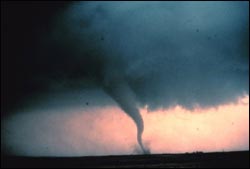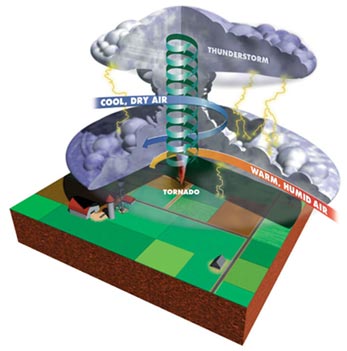
Tornadoes
The Basics
 |
| The tornado funnel forms, kicking up dust and debris
from the ground. (Photo: NOAA) |
What is it?
A tornado is a violently rotating column of air that descends from a
thunderstorm. No other weather phenomenon can match the fury and destructive
power of tornadoes. They can destroy large buildings, lift 20-ton railroad
cars from their tracks, and drive straw and blades of grass into trees
and telephone poles.
Tornado winds can reach 300 miles per hour.
How do they work?
In order to form a tornado, you need three very different types of air
to come together in a particular way:
- Near the ground, there's a layer of warm, humid air and strong south
winds. In the upper atmosphere, you'll find colder air and strong west
or southwest winds. The air near the surface is much less dense than
the cold, dry air aloft. This condition is called instability.
It means that if the warm, moist air can be given an initial push to
move upwards, the air will keep on rising, sending moisture and energy
to form a tornado's parent thunderstorm.
- The second ingredient is a change in wind speed and direction with
height, called wind shear. This is linked to the eventual development
of rotation from which a tornado may form.
- The last thing you need is a layer of hot, dry air between the upper
and lower layers. This middle layer acts as a cap and allows the warm
air underneath to get even warmer and make the atmosphere even less
stable.
When a storm system high in the atmosphere moves east and begins to lift
the layers, it begins to build severe thunderstorms that spawn tornadoes.
As it lifts it removes the cap, setting the stage for explosive thunderstorms
to develop as strong updrafts form. If the rising air encounters wind
shear, it may cause the updraft to begin rotating, and a tornado is born.

Learn more about tornadoes in-depth.
|



